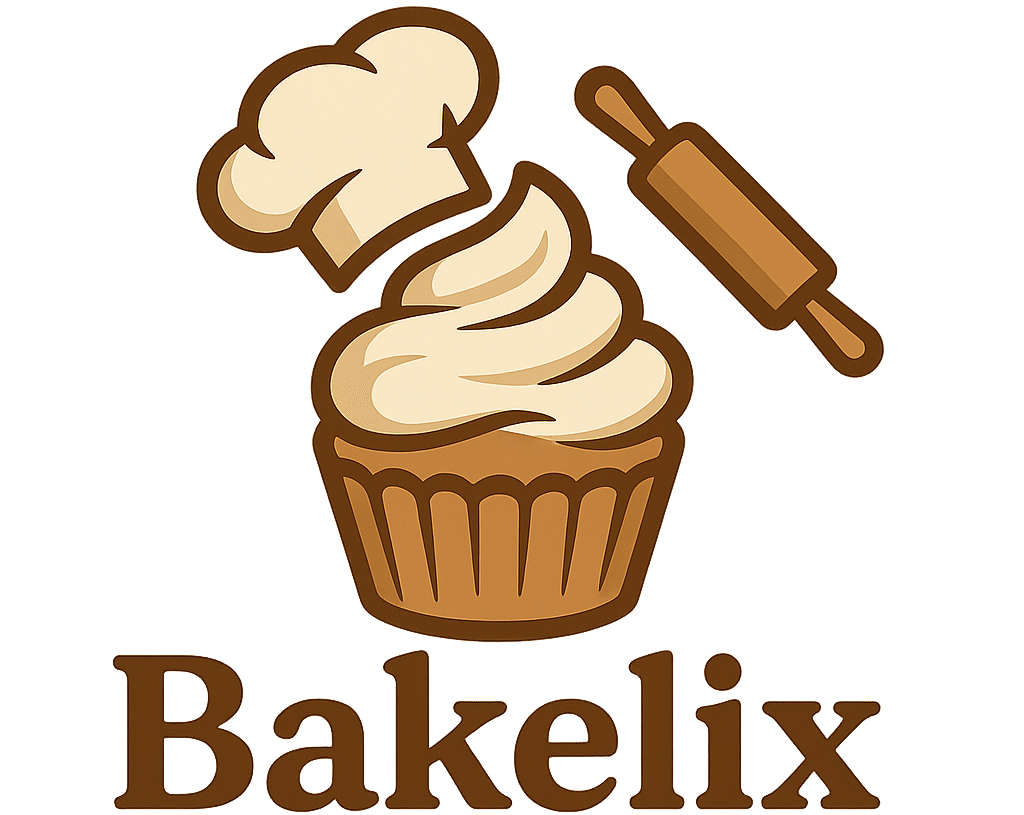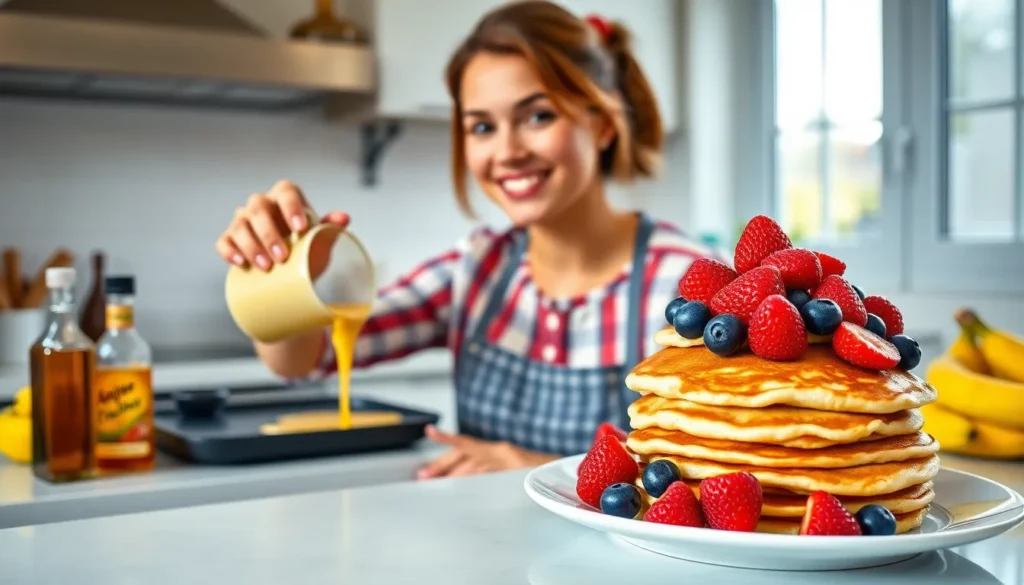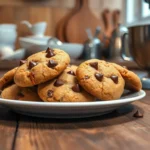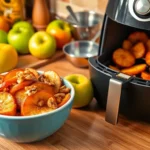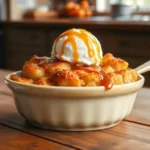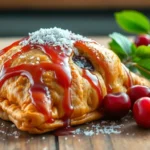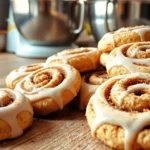We’ve all been there – craving fluffy pancakes on a lazy weekend morning only to discover we’re completely out of milk. The good news? You don’t need milk to make incredible pancakes that rival any traditional recipe.
These dairy-free pancakes prove that sometimes the best answers come from working with what we have. Whether you’re dealing with lactose intolerance, following a vegan lifestyle, or simply facing an empty fridge, this recipe delivers the same golden, fluffy results you’d expect from classic pancakes.
What makes these pancakes special isn’t just what they’re missing – it’s how perfectly they turn out without any compromise on taste or texture. We’ll show you how simple ingredient swaps can create pancakes so delicious that you might never go back to the traditional version.
Ingredients
We’ve carefully selected these dairy-free ingredients to create pancakes that are just as fluffy and delicious as traditional versions. Each substitute serves a exact purpose in achieving that perfect pancake texture and flavor.
For the Pancakes:
- 2 cups all-purpose flour
- 2 tablespoons granulated sugar
- 2 teaspoons baking powder
- 1 teaspoon salt
- 2 large eggs
- 1¾ cups water (or substitute of choice)
- 3 tablespoons vegetable oil or melted coconut oil
- 1 teaspoon vanilla extract
Milk Alternatives (choose one):
- Water (most basic option)
- Unsweetened almond milk
- Oat milk
- Coconut milk (canned or carton)
- Soy milk
- Rice milk
Optional Flavor Enhancers:
- 1 tablespoon lemon juice (for extra fluffiness)
- ½ teaspoon cinnamon
- 2 tablespoons melted butter substitute
The beauty of these ingredients lies in their accessibility. Water works perfectly as our primary milk substitute and creates surprisingly light pancakes. Vegetable oil replaces the fat content typically provided by milk while maintaining moisture. Eggs act as our binding agent and contribute to the fluffy texture we’re after.
Our liquid measurements remain flexible depending on your chosen milk alternative. Thicker options like coconut milk may require slight adjustments to achieve the ideal batter consistency.
Equipment Needed

Creating perfect dairy-free pancakes requires having the right tools on hand to ensure smooth preparation and consistent results. We’ve compiled a list of essential equipment that will make your pancake-making process effortless and enjoyable.
Large mixing bowl serves as your primary workspace for combining ingredients. We recommend using a bowl with at least 3-quart capacity to prevent spillage when whisking the batter.
Whisk or fork helps you blend wet and dry ingredients thoroughly. A whisk creates better aeration for fluffier pancakes, though a sturdy fork works perfectly well for achieving smooth batter consistency.
Non-stick griddle or large pan provides the cooking surface for your pancakes. We prefer griddles because they allow you to cook multiple pancakes simultaneously, making breakfast preparation faster for families or groups.
Spatula ensures safe and easy pancake flipping without damaging the delicate surface. Choose a thin, flexible spatula that slides easily under the pancakes without breaking them.
Measuring cups and spoons guarantee accurate ingredient ratios for consistent results every time. We use both dry and liquid measuring cups to ensure precision, especially when substituting traditional milk with water or plant-based alternatives.
Having these basic tools ready before you start cooking streamlines the entire process. Your kitchen likely already contains most of these items, making this recipe accessible without requiring specialized equipment purchases.
Instructions
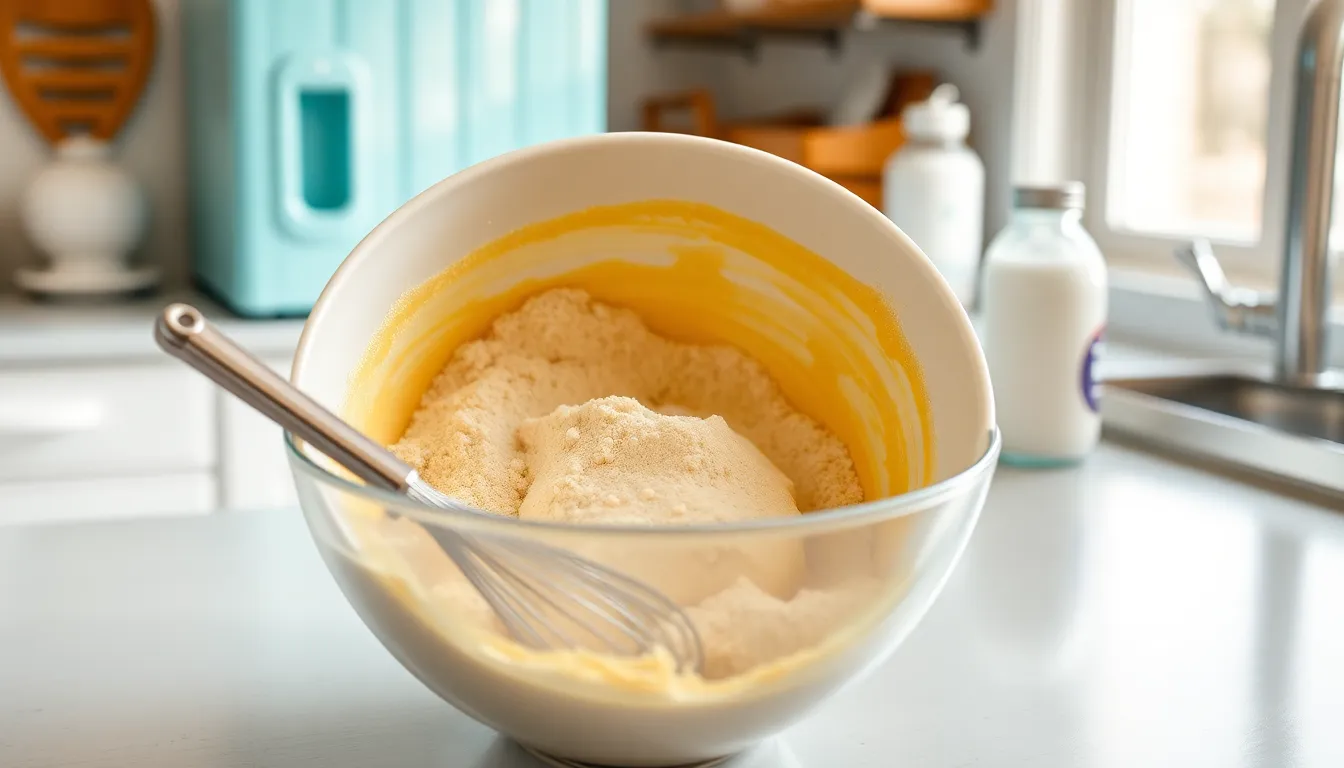
These step-by-step instructions will guide you through creating perfectly fluffy pancakes without milk. Let’s break down the process into manageable stages for the best results.
Prep the Dry Ingredients
Start by gathering your dry ingredients in a large mixing bowl. Measure 1 ½ cups (180-190 grams) of all-purpose flour and add it to the bowl. Add 2 ½ teaspoons of baking powder for maximum fluffiness, ensuring you use aluminum-free baking powder to avoid any metallic aftertaste. Sprinkle in ½ teaspoon of salt and 1 ½ tablespoons of sugar for the perfect balance of flavor.
Whisk all the dry ingredients together until they’re evenly distributed. This initial mixing prevents clumping and ensures our pancakes will have consistent texture throughout.
Prepare the Wet Ingredients
In a separate bowl, combine your liquid ingredients for the smoothest batter. Pour 1 to 1 ¼ cups of water into the bowl (you can substitute with your preferred plant-based milk if desired). Crack one large egg into the mixture and whisk until well incorporated.
Add 3 tablespoons of melted butter or neutral-tasting oil to provide richness and prevent sticking. Pour in 2 teaspoons of vanilla extract for that classic pancake flavor. Whisk all wet ingredients together until the mixture is smooth and well combined.
Combine and Mix the Batter
Create a well in the center of your dry ingredients using a spoon or your whisk. Pour the wet ingredient mixture directly into this well. Using a whisk or large spoon, gently fold the ingredients together until just combined.
Resist the urge to overmix the batter. Small lumps are perfectly acceptable and will disappear during cooking. Overmixing develops the gluten too much and results in tough, less fluffy pancakes.
Cook the Pancakes
Heat your non-stick griddle or large skillet over medium heat until it reaches 300-350°F. Lightly grease the surface if needed, though most non-stick surfaces won’t require additional oil.
Pour ¼ to ⅓ cup of batter per pancake onto the hot griddle. Watch for bubbles to form on the surface and the edges to look set before flipping. The bottom should be golden brown, which typically takes 2-3 minutes. Flip carefully with your spatula and cook the second side for 1-3 minutes until golden brown.
Serve the pancakes immediately for the best texture and flavor. Re-grease your pan between batches as needed to prevent sticking.
Milk Substitutes That Work Best
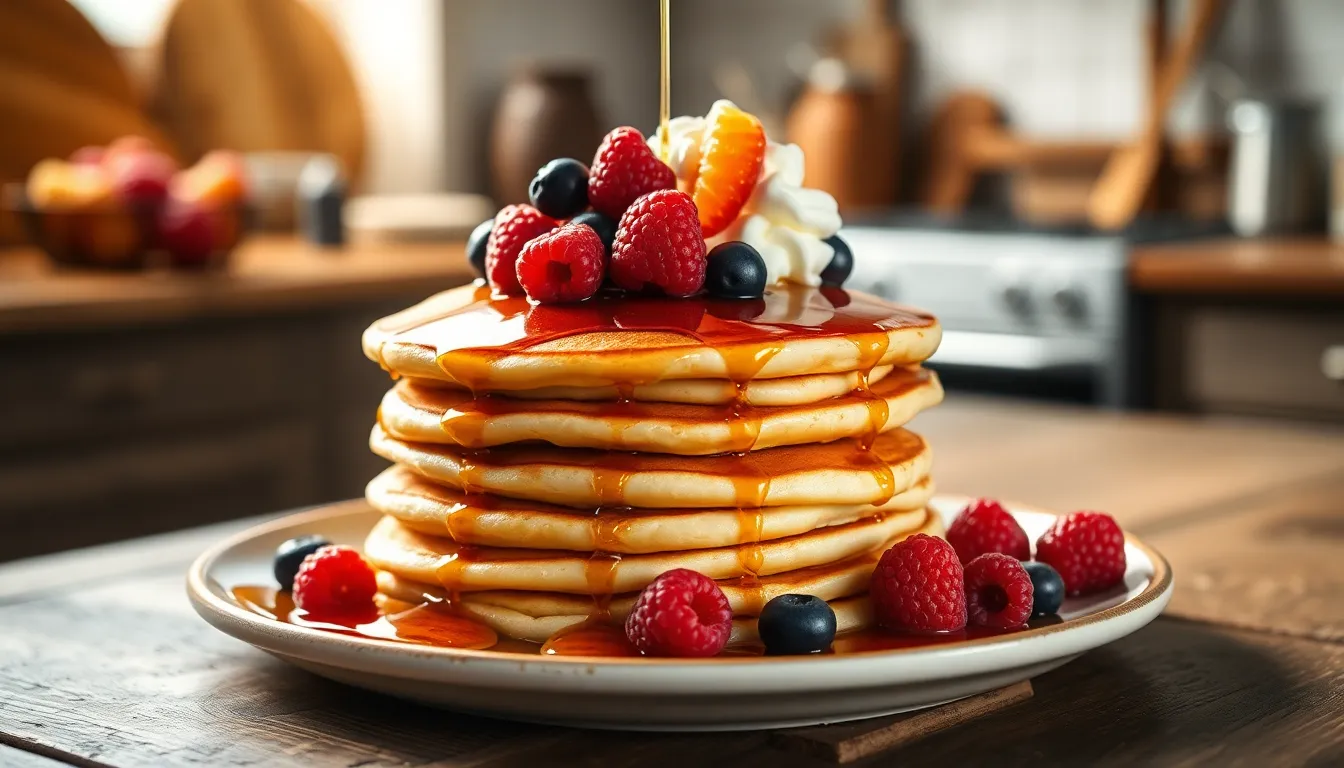
When we need to make pancakes without traditional milk, several excellent alternatives can deliver the same fluffy texture and delicious taste. These substitutes range from simple water-based options to rich plant-based alternatives that enhance flavor.
Water-Based Options
Water serves as the most accessible substitute for milk in pancake recipes. We can use it as a direct 1:1 replacement without any additional modifications to our recipe. The pancakes will have a slightly lighter texture compared to those made with milk, but they remain perfectly fluffy and enjoyable.
For richer results, we recommend combining water with other ingredients. Heavy cream mixed with water creates an excellent substitute that maintains the creamy texture we expect from traditional pancakes. Half-and-half works similarly when diluted with water to achieve the proper consistency.
Yogurt and sour cream offer another water-based approach. We mix these thick dairy products with water until they reach a milk-like consistency. This combination provides extra richness and a subtle tang that enhances the overall flavor profile.
Plant-Based Milk Alternatives
Almond milk stands out as one of the most popular plant-based substitutes for pancakes. We use it in a 1:1 ratio with regular milk, and it produces light, fluffy pancakes with a subtle nutty undertone. The consistency works perfectly without requiring any adjustments to our cooking technique.
Oat milk delivers a richer texture compared to other plant-based options. Its natural creaminess makes it an ideal choice when we want pancakes that closely mimic the traditional dairy version. The slightly sweet flavor complements our pancake batter beautifully.
Soy milk provides excellent results and has gained popularity in dairy-free baking. We substitute it directly for milk in equal amounts, and it creates pancakes with a tender crumb and neutral taste that pairs well with any toppings.
Coconut milk brings a luxurious creaminess to our pancakes. We use it in a 1:1 ratio, though we can dilute it with water if we prefer a lighter consistency. The subtle coconut flavor adds an exotic touch without overwhelming the classic pancake taste.
Other Creative Substitutes
Coconut cream offers an ultra-rich option for special occasion pancakes. Since it’s thicker than regular milk, we mix two parts coconut cream with one part water to achieve the ideal consistency. This creates incredibly decadent pancakes with a velvety texture.
Hemp milk provides another nutritious alternative that works well in pancake recipes. We substitute it directly for regular milk, and it contributes a slightly nutty flavor while maintaining the proper batter consistency.
Rice milk serves as an excellent option for those with multiple food sensitivities. Its thin consistency closely resembles regular milk, making it easy to use without recipe modifications. The mild flavor ensures our pancakes taste familiar and comforting.
Tips for Perfect Dairy-Free Pancakes
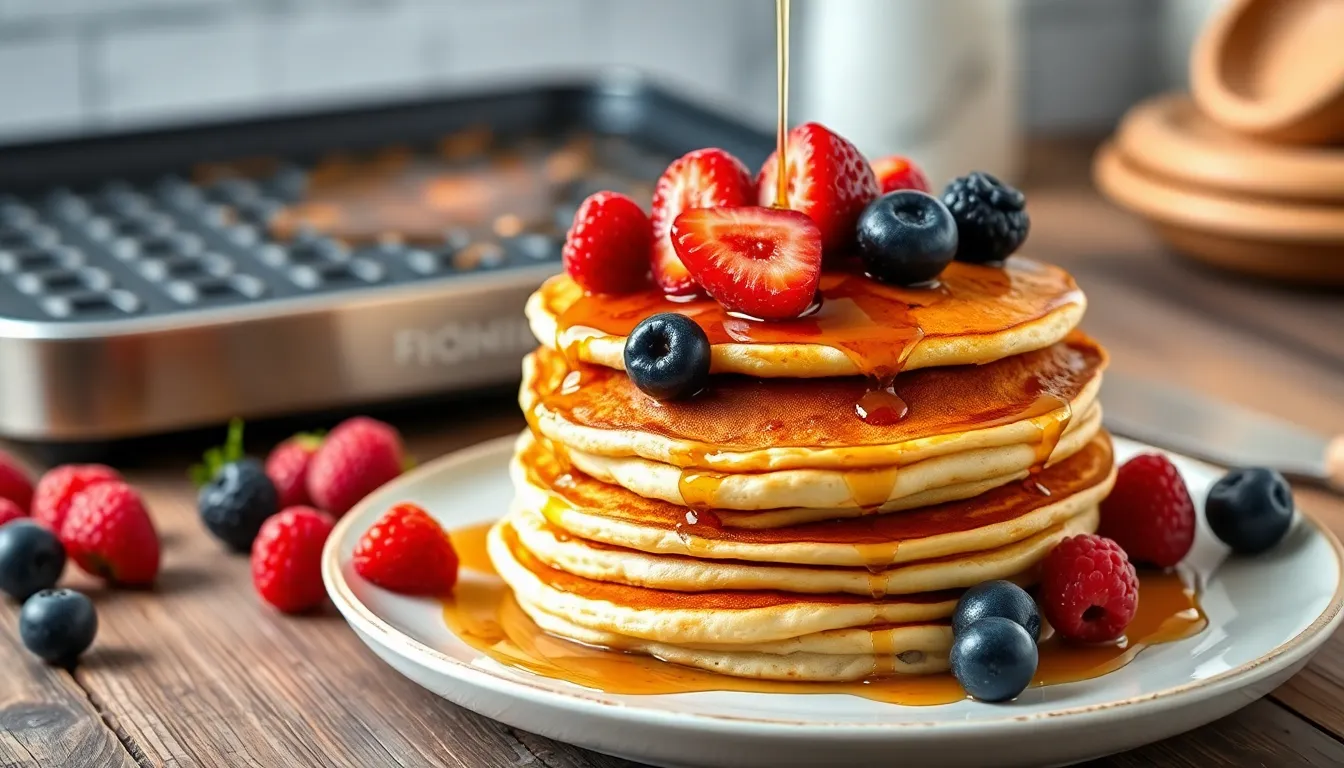
Achieving restaurant-quality dairy-free pancakes requires attention to exact techniques that ensure fluffy, delectable results every time. We’ve discovered that success lies in mastering the liquid-to-dry ingredient ratio and understanding how different dairy alternatives behave in pancake batter.
Master the Liquid Balance
Getting the right ratio of liquid to dry ingredients prevents dense, heavy pancakes that can disappoint even the most patient breakfast enthusiast. We recommend starting with slightly less liquid than traditional recipes call for, then gradually adding more until the batter reaches the perfect consistency. The ideal batter should pour easily but still hold its shape when dropped onto the griddle.
Avoid Overmixing at All Costs
Gentle mixing preserves the light, airy texture that makes pancakes irresistible. We combine our wet and dry ingredients with just enough stirring to bring them together, leaving small lumps intact. Overmixing develops gluten strands that create tough, chewy pancakes instead of the tender texture we’re after.
Maximize Baking Powder Effectiveness
Baking powder becomes especially crucial when working without dairy products. We ensure our baking powder is fresh and use it generously to compensate for the reduced richness that milk typically provides. Double-acting baking powder works best, giving pancakes two opportunities to rise and achieve maximum fluffiness.
Choose Your Dairy Alternative Wisely
| Milk Alternative | Best For | Texture Result |
|---|---|---|
| Oat Milk | Neutral flavor, fluffy texture | Light and airy |
| Almond Milk | Light consistency | Tender and delicate |
| Soy Milk | Vegan recipes | Slightly nutty, substantial |
| Coconut Milk | Rich flavor preference | Creamy and dense |
Maintain Optimal Cooking Temperature
We keep our griddle at medium heat to ensure even cooking without burning the exterior before the interior sets. A properly heated surface creates that perfect golden-brown color while allowing the pancakes to cook through completely.
Keep Pancakes Warm During Batch Cooking
Serving all pancakes at the same temperature enhances the dining experience significantly. We place finished pancakes in a low oven (around 200°F) while cooking subsequent batches, ensuring everyone enjoys warm, fresh-tasting pancakes simultaneously.
Use Quality Vegetable Oils
Canola or coconut oil substitutes effectively for butter, providing the necessary fat content for tender pancakes. We prefer neutral-flavored oils that won’t compete with our chosen toppings or mix-ins.
Serving Suggestions
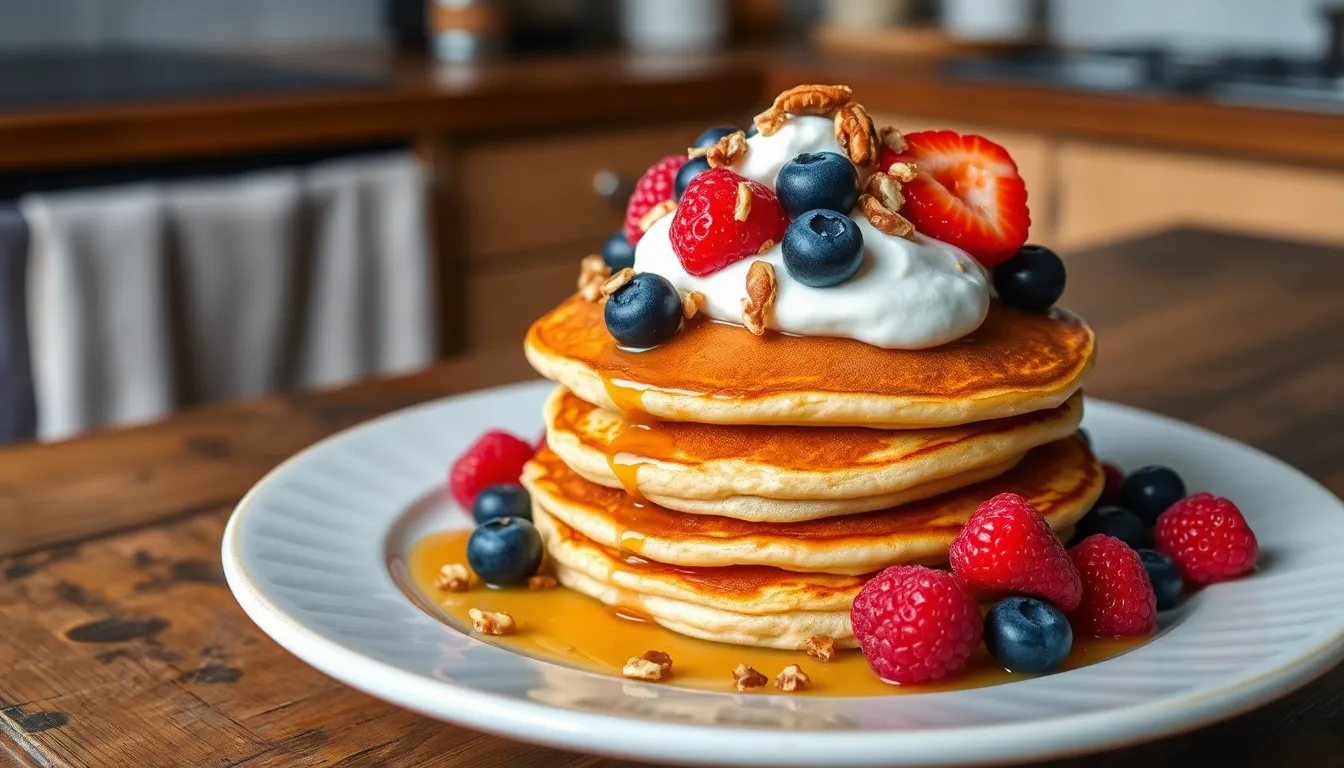
We love transforming our dairy-free pancakes into a memorable breakfast experience with thoughtful toppings and accompaniments. These fluffy pancakes serve as the perfect canvas for both classic and creative serving ideas that enhance their natural flavor.
Traditional Sweet Options
Maple syrup remains our top recommendation for these milk-free pancakes. The natural sweetness complements the subtle vanilla notes in our recipe beautifully. Honey offers another excellent choice, providing a floral sweetness that pairs wonderfully with the pancakes’ tender texture. Fresh fruits elevate both the visual appeal and nutritional value of your breakfast plate.
Fresh Fruit Combinations
We recommend arranging sliced strawberries, blueberries, and raspberries on top of warm pancakes. Banana slices add natural sweetness and create a satisfying texture contrast. For a more sophisticated presentation, we suggest macerating berries with a touch of sugar to create a natural fruit syrup that soaks into the pancakes.
Indulgent Additions
Whipped cream provides a luxurious finishing touch that transforms these pancakes into a special occasion breakfast. We often use dairy-free whipped coconut cream to maintain the milk-free theme. Chocolate chips or mini chocolate morsels scattered over warm pancakes create delightful pockets of sweetness that appeal to both children and adults.
Texture Enhancers
Chopped nuts such as pecans, walnuts, or almonds add a satisfying crunch that contrasts beautifully with the soft pancake texture. We particularly enjoy toasted nuts for their enhanced flavor profile. Coconut flakes provide another excellent textural element while reinforcing the dairy-free nature of the meal.
Creative Serving Ideas
Pancake stacks with alternating layers of fresh fruit and dairy-free yogurt create an impressive presentation. We also recommend serving these pancakes with a side of crispy bacon or breakfast sausage for those who enjoy sweet and savory combinations. Nut butters like almond or peanut butter can be drizzled on top for added protein and richness.
Storage and Reheating Instructions

Proper storage keeps our dairy-free pancakes fresh and delicious for days after cooking. We recommend letting pancakes cool completely on a wire rack before storing them to prevent condensation from making them soggy.
Refrigerator Storage: Place cooled pancakes in an airtight container and store them in the refrigerator for up to 3 days. We suggest separating layers with parchment paper to prevent sticking.
Freezer Storage: For longer storage we can freeze our pancakes for up to 2 months. Wrap individual pancakes in plastic wrap or place them in freezer-safe bags with parchment paper between each pancake.
Reheating Methods
Toaster Method: We find reheating pancakes in a toaster or toaster oven at 350°F (175°C) works best for restoring their original fluffy texture. This method takes 2-3 minutes and gives us crispy edges with a warm center.
Microwave Method: For quick reheating we can microwave pancakes for 20-30 seconds per pancake. Place them on a microwave-safe plate and cover with a damp paper towel to prevent drying out.
Oven Method: When reheating multiple pancakes we recommend using the oven at 350°F (175°C) for 5-8 minutes. Place pancakes on a baking sheet and cover with foil to maintain moisture.
Skillet Method: We can also reheat pancakes in a lightly greased skillet over medium-low heat for 1-2 minutes per side. This method helps restore the original texture and warmth.
| Storage Method | Duration | Temperature |
|---|---|---|
| Refrigerator | Up to 3 days | 40°F or below |
| Freezer | Up to 2 months | 0°F or below |
| Toaster Reheat | 2-3 minutes | 350°F |
| Oven Reheat | 5-8 minutes | 350°F |
Recipe Variations

Our dairy-free pancake base opens the door to countless delicious adaptations. We can easily modify our recipe to accommodate different dietary needs and flavor preferences.
Gluten-Free Option
We substitute all-purpose flour with a quality gluten-free flour blend for celiac-friendly pancakes. Our testing shows that equal parts substitution works perfectly in most cases. Adding xanthan gum helps create the structure that gluten typically provides.
We recommend using a certified gluten-free flour blend that contains rice flour and potato starch for optimal texture. The pancakes may require an extra minute of cooking time per side. We find that letting the batter rest for 5 minutes before cooking improves the final texture significantly.
Vegan Version
Our vegan adaptation replaces the egg with a simple flax egg made from 1 tablespoon ground flaxseed mixed with 3 tablespoons water. We let this mixture sit for 5 minutes until it becomes gel-like. Dairy-free butter or neutral oil replaces any butter in the recipe.
We achieve the same light and fluffy texture using this plant-based approach. The flax egg provides binding power while adding beneficial omega-3 fatty acids. Our vegan pancakes cook identically to the original recipe and deliver satisfying results every time.
Flavored Pancakes
We transform our basic recipe into exciting flavor variations with simple additions. Mashed ripe banana replaces both sugar and a portion of the water for naturally sweet banana pancakes. Adding 1 teaspoon cinnamon creates warm spiced pancakes perfect for fall mornings.
Fresh blueberries or chocolate chips fold beautifully into our batter without affecting cooking times. We recommend adding ¼ cup of mix-ins per batch for balanced flavor distribution. Vanilla extract can be increased to 1 tablespoon for enhanced vanilla pancakes that taste bakery-quality.
Conclusion
We’ve shown you that creating delicious pancakes without milk isn’t just possible—it’s surprisingly simple and satisfying. With the right ingredient swaps and techniques you now have everything needed to whip up fluffy dairy-free pancakes that’ll impress everyone at your breakfast table.
Whether you’re accommodating dietary restrictions or simply ran out of milk these pancakes deliver on taste and texture every time. The versatility of milk alternatives and flavor variations means you’ll never get bored with your morning stack.
Now it’s time to heat up that griddle and start flipping! Your perfect dairy-free pancake breakfast awaits.
Frequently Asked Questions
Can I make pancakes without milk and still get fluffy results?
Yes! You can make perfectly fluffy pancakes without milk by using water or plant-based milk alternatives like almond milk, oat milk, or soy milk. The key is maintaining the right liquid-to-dry ingredient ratio and using fresh baking powder for optimal lift.
What are the best dairy-free milk substitutes for pancakes?
The best dairy-free substitutes include almond milk, oat milk, soy milk, and coconut milk for rich flavor. For basic recipes, plain water works well. Other options include rice milk, hemp milk, and coconut cream for different textures and tastes.
How do I prevent dairy-free pancakes from being tough?
Avoid overmixing the batter, which develops gluten and creates tough pancakes. Gently combine wet and dry ingredients until just mixed – a few lumps are okay. Also, use fresh double-acting baking powder and cook at medium temperature for best results.
Can I make these pancakes vegan?
Absolutely! Replace the egg with a flax egg (1 tablespoon ground flaxseed mixed with 3 tablespoons water, let sit 5 minutes). Use plant-based milk alternatives and vegetable oil or melted coconut oil instead of butter.
How long do dairy-free pancakes stay fresh?
Store cooled pancakes in an airtight container in the refrigerator for up to 3 days or freeze for up to 2 months. Reheat using a toaster, microwave, oven, or skillet to restore their fluffy texture.
What equipment do I need to make dairy-free pancakes?
You’ll need basic kitchen tools: a large mixing bowl (3-quart capacity), whisk or fork, non-stick griddle or large pan, thin flexible spatula for flipping, and measuring cups and spoons. Most home cooks already have these items.
Can I make gluten-free dairy-free pancakes?
Yes! Substitute all-purpose flour with a gluten-free flour blend and add a pinch of xanthan gum for structure. Follow the same method, but you may need to adjust liquid amounts slightly based on your flour blend.
